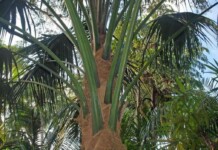
In the Canary Islands, in Barcelona, and in Chile, a unique fog catcher design is sustaining dry forests with water without emissions, or even infrastructure.
Replicating how pine needles catch water, the structure need only be brought on-site and set up, without roads, powerlines, or irrigation channels.
Fog catching is an ancient practice—renamed “cloud milking” by an EU-funded ecology project on the Canary Islands known as LIFE Nieblas (nieblas means fog).
“In recent years, the Canaries have undergone a severe process of desertification and we’ve lost a lot of forest through agriculture. And then in 2007 and 2009, as a result of climate change, there were major fires in forested areas that are normally wet,” said Gustavo Viera, the technical director of the publicly-funded project in the Canaries.
The Canaries routinely experience blankets of fog that cloak the islands’ slopes and forests, but strong winds made fog-catching nets an unfeasible solution. In regions such as the Atacama Desert in Chile or the Atlas Mountains of North Africa, erecting nets that capture moisture particles out of passing currents of fog is a traditional practice.
LIFE Nieblas needed a solution that could resist powerful winds, and to that end designed wind chime-like rows of artificial pine needles, which are also great at plucking moisture from the air. However, unlike nets or palms, they efficiently let the wind pass through them.
The water is discharged without any electricity. There are no irrigation channels, and no machinery is needed to transport the structures. The natural course of streams and creeks need not be altered, nor is there a need to drill down to create wells. The solution is completely carbon-free.
WATER IN THE DESERTS:
- China Announces Completion of a 1,800-Mile Green Belt Around the World’s Most-Hostile Desert
- Billions of People Could Benefit from This Breakthrough in Desalination That Ensures Freshwater for the World
- Scientists Perfecting New Way to Turn Desert Air into Water at Much Higher Yields
- Sahara Desert Is Turning Green Amid Unusual Rains in Parts of North Africa
- Indian Engineers Tackle Water Shortages with Star Wars Tech in Kerala
In the ravine of Andén in Gran Canaria, a 35.8-hectare (96 acres) mixture of native laurel trees irrigated by the fog catchers enjoys a survival rate of 86%, double the figure of traditional reforestation.
“The Canaries are the perfect laboratory to develop these techniques,” said Vicenç Carabassa, the project’s head scientist, who works for the Center for Ecological Research and Forestry Applications at the University of Barcelona. “But there are other areas where the conditions are optimal and where there is a tradition of water capture from fog, such as Chile and Morocco.”
In Chile’s Coquimbo province, the town of Chungungo is collecting around 250 gallons a day from a combination of locally-made fog catchers at LIFE Nieblas’ pine needle design, the Guardian reports.
SHARE This Cutting-Edge Fog Catcher Already In Use Around The World…




















